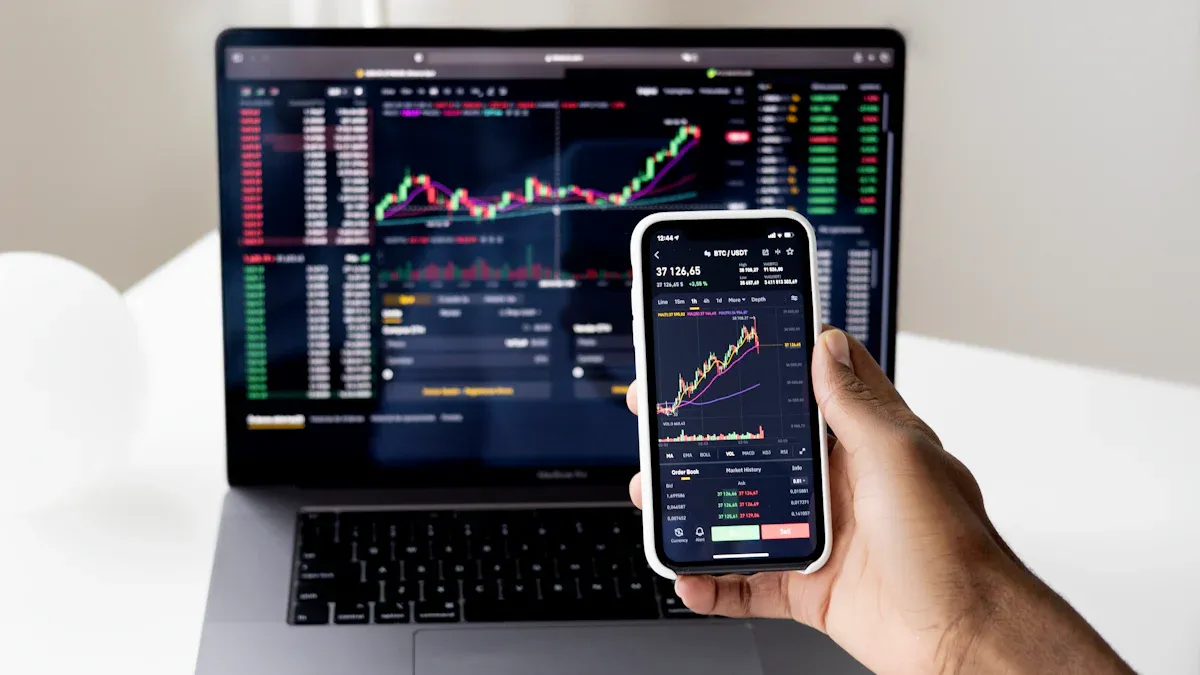Image Source: unsplash
Technology is revolutionizing how we approach alternative investments. It’s no longer just for institutional investors. Digital platforms now offer fractional ownership, making it easier for individuals to invest in real estate or startups with minimal capital. This democratization has opened doors for countless investors. Case Studies in Tech-Driven Alternative Investments show how AI and fintech improve decision-making, reduce barriers, and enhance returns.
Key Takeaways
- Technology makes alternative investments available to more people. Online tools let people invest small amounts in real estate and startups.
- AI helps make better investment choices. It studies large data fast, finding risks and chances that old methods may not see.
- Blockchain makes transactions safer and clearer. It lowers fraud risks and makes ownership checks easier, helping more people invest in real estate.
Understanding Tech-Driven Alternative Investments
Defining Alternative Investments
When I think about alternative investments, I see them as opportunities beyond traditional stocks and bonds. These include private equity, venture capital, real estate, hedge funds, and even private debt. Unlike conventional investments, these options often provide higher returns but come with unique risks. What excites me most is how technology is reshaping these investments. For example, venture capital firms now use AI to analyze massive datasets, uncovering promising startups faster than ever. Private equity firms rely on big data to identify trends and make smarter decisions. Even private debt markets are evolving with AI-driven credit scoring, which improves risk assessment. These advancements show how technology is transforming the way we invest.
The Role of Technology in Modern Investments
Technology has become the backbone of modern investing. It’s not just about convenience; it’s about creating smarter, more efficient systems. Blockchain, for instance, enhances transparency by providing immutable transaction histories. This builds trust among investors and reduces fraud risks. Automation, through smart contracts, speeds up transactions and cuts costs. Digital platforms have also lowered entry barriers, allowing more people to participate in alternative investments. I’ve seen how these tools democratize access, making it possible for anyone to own a piece of real estate or invest in a startup. This shift is not just a trend; it’s a revolution.
Benefits of Tech Integration in Alternative Investments
The benefits of integrating technology into alternative investments are undeniable. First, it enhances transparency. Blockchain ensures every transaction is secure and verifiable. Second, it democratizes access. Digital platforms enable fractional ownership, allowing investors to start with minimal capital. Third, it improves decision-making. Predictive analytics and AI tools provide insights that were once unimaginable. Finally, it streamlines operations. Automation reduces inefficiencies, saving time and money. These advancements don’t just make investing easier; they make it smarter. Case Studies in Tech-Driven Alternative Investments highlight how these innovations are changing the game, offering lessons for anyone looking to stay ahead.
Case Studies in Tech-Driven Alternative Investments
AI in Risk Management and Decision-Making
AI has completely transformed how I approach risk management and decision-making in investments. It’s like having a crystal ball that analyzes vast amounts of data in real time. For instance, AI systems like IBM Watson for Risk Management identify emerging risks instantly. This allows financial institutions to act before problems escalate. Similarly, Moody’s Analytics uses AI to evaluate credit risks and predict potential defaults. These tools don’t just save time; they also improve accuracy.
Here’s a quick look at how AI is being used in this space:
| Example | Use Case | Description |
|---|---|---|
| IBM Watson for Risk Management | Operational risk analysis | Identifies emerging risks in real-time, enabling proactive responses. |
| Moody’s Analytics | Credit risk management | Evaluates credit risks and forecasts potential defaults. |
AI also enhances decision-making by analyzing financial data and market indicators simultaneously. It identifies opportunities that traditional methods might miss. Machine learning algorithms adapt to market changes, creating dynamic strategies. This blend of human intuition and computational power bridges gaps and ensures smarter investment decisions.
Blockchain Enhancing Transparency in Real Estate
Blockchain has revolutionized real estate investments by making processes more transparent and secure. I’ve seen how it reduces fraud and disputes through its immutable transaction records. Every transaction is stored on a tamper-proof ledger, which eliminates the need for third-party verification. This builds trust and simplifies ownership verification.
For example, blockchain enables smart contracts that automate property transactions. These contracts execute automatically when conditions are met, reducing intermediaries and saving time. Additionally, tokenization allows fractional ownership of real estate assets. This increases market liquidity and opens doors for smaller investors. Blockchain also replaces paper deeds with digital assets, making property registries more secure and accessible.
With blockchain, I can instantly access verified property histories. This reduces risks and ensures smoother transactions. It’s a game-changer for anyone looking to invest in real estate with confidence.
Challenges and Risks in Technology Adoption
Cybersecurity Threats in Digital Investment Platforms
Cybersecurity is one of the biggest challenges I face when using digital investment platforms. With the rise of online transactions, the risk of cyberattacks has grown exponentially. Hackers target sensitive financial data, which can lead to devastating breaches. To mitigate these risks, I rely on advanced tools like Cyber Risk Quantification (CRQ) platforms. These platforms transform raw security data into actionable insights, helping me prioritize threats based on their potential financial impact.
Here are some key features I look for in a CRQ platform:
- Scalability to handle growing data volumes.
- Integration capabilities for seamless operation.
- Customization to meet specific security needs.
- Automation to streamline threat detection.
- User-friendly dashboards for quick decision-making.
By adopting these tools, I can protect my investments and ensure a secure digital environment.
Navigating Regulatory and Compliance Issues
Regulatory challenges often feel like a maze. Governments and financial authorities are increasing oversight, which reshapes how I approach alternative investments. Compliance varies by jurisdiction, making it even more complex. For example, data privacy and security regulations are critical when using AI for decision-making.
The key to effective compliance lies in adopting technologies that streamline processes and enhance security. In the BFSI sector, where data integrity is paramount, leveraging cutting-edge solutions becomes essential.
I’ve learned that staying ahead of regulatory changes builds trust with investors. By proactively integrating these requirements, I not only avoid penalties but also attract clients who value transparency and sustainability.
Balancing Innovation with Investor Confidence
Balancing innovation with investor confidence is a delicate act. I’ve found that diversifying my portfolio reassures stakeholders about stable growth. A phased development approach also works well. It allows me to test new technologies, gather feedback, and make adjustments without overwhelming investors.
Regular communication is another strategy I use. By providing updates on financial performance and innovation milestones, I manage expectations effectively. This approach not only builds trust but also ensures that my innovations align with market trends and investor comfort.
Technology adoption comes with risks, but with the right strategies, I can navigate these challenges while maintaining confidence and driving growth.
Future Trends and Strategic Recommendations

Image Source: unsplash
The Emergence of Tokenized Assets
Tokenized assets are reshaping the future of alternative investments. By representing assets as programmable code on a blockchain, tokenization introduces features like fractional ownership and enhanced liquidity. This innovation lowers entry barriers, allowing more people to invest in private equity, real estate, and even fine art. For example:
- The tokenization of Pablo Picasso’s “Fillette au beret” enabled fractional ownership through 4,000 tokens.
- Damien Hirst’s “Everyday Objects” collection used tokenization to manage ownership rights.
- Beeple’s digital artwork “Everydays—The First 5000 Days” sold for $69.3 million, showcasing the financial potential of tokenized assets.
Tokenization doesn’t just democratize access; it also enhances transparency. Blockchain’s shared data ensures every transaction is secure and verifiable. This technology is transforming private assets, making them more accessible and tradable.
Predictive Analytics for Smarter Investments
Predictive analytics is revolutionizing investment strategies. AI copilots analyze large datasets to identify market patterns, predict movements, and assess risks. This proactive approach helps me time market entry and exit strategically. For instance, I’ve seen how predictive tools forecast trends, enabling smarter decisions. However, challenges like data quality and transparency remain. Poor data can lead to inaccuracies, while complex models may erode client trust.
| Limitation/Challenge | Description |
|---|---|
| Data Quality | Inaccurate data can disrupt analytics and decision-making. |
| Lack of Transparency | Complex models may confuse clients, reducing confidence. |
Despite these challenges, predictive analytics offers immense potential for smarter, data-driven investments.
Strategic Steps for Investors and Firms
Adapting to technological trends requires strategic action. Investors should embrace digital platforms for broader participation and leverage data-driven tools to identify trends and risks. Firms must focus on blockchain and AI to enhance transparency and decision-making. For example, blockchain facilitates tokenization, while AI improves deal sourcing and portfolio management. Proactive adaptation to these technologies ensures alignment with market demands and fiduciary responsibilities.
By staying ahead of these trends, I can position myself to capitalize on the evolving landscape of alternative investments. Case Studies in Tech-Driven Alternative Investments highlight the importance of embracing these innovations to remain competitive.
Technology has redefined alternative investments, making them smarter and more accessible. Case studies reveal the importance of due diligence and selectivity in overcoming challenges like illiquidity and performance variability.
The rise of digital platforms and tokenization enables fractional ownership, connecting investors globally and democratizing access to high-value assets.
This transformation empowers investors to seize new opportunities confidently.
FAQ
What are the key benefits of tech-driven alternative investments?
Tech-driven investments offer transparency, accessibility, and smarter decision-making. Tools like blockchain and AI simplify processes, reduce risks, and open opportunities for all investors. 🚀
How can I start investing in tokenized assets?
Use trusted platforms offering fractional ownership. Research thoroughly, evaluate risks, and start small. Tokenized assets make it easier to diversify your portfolio with minimal capital.
Are digital investment platforms safe?
Yes, if you choose platforms with strong cybersecurity measures. Look for encryption, two-factor authentication, and compliance with regulations to protect your investments.




